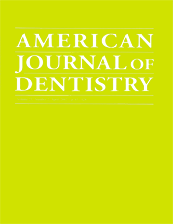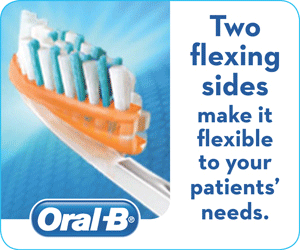
Biomechanical degradation of the
nano-filled resin-modified glass-ionomer
surface Suzana
Beatriz Portugal de FÚcio, dds, ms, phd,
AndrÉia Bolzan de Paula, dds, ms, phd, FabÍola
Galbiatti de Carvalho, dds, ms, phd,
Victor Pinheiro Feitosa, dds, ms Glaucia
Maria B. Ambrosano, dds, ms, phd
& Regina Maria Puppin-Rontani, dds, ms, phd Abstract: Purpose: To evaluate in the laboratory
the roughness (Ra) and micromorphology surface of the nanofilled resin-modified
glass-ionomer (Ketac N100) subjected to biomechanical degradation, compared to
Vitremer, Ketac Molar Easymix and Fuji IX. Methods: Specimens obtained
from the ionomers were divided into two storage groups (n=10): relative
humidity and S. mutans biofilm (biodegradation). After 7 days, Ra values
and micrographs were obtained. Then, the brushing abrasion test (mechanical
degradation) was conducted with dentifrice slurry (three-body) and the
specimens were reassessed. Data were submitted to repeated measures three-way
ANOVA and Tukey tests (P< 0.05). Results: There was significant
interaction among the factors: material, storage and abrasion (before/after).
Vitremer showed similar Ra values between storage groups, while the other
materials presented higher Ra values after biodegradation test. Concerning
biomechanical challenge, Ketac N100 presented the lowest Ra values. Ketac Molar
Easymix and Fuji IX presented undesirable roughening of their surfaces under
the detrimental conditions tested. The eroded aspect after biodegradation with
filler exposure after mechanical degradation was evident. (Am J Dent
2012;25:315-320). Clinical
significance:
The nano-ionomer Ketac N100 presented a satisfactory resistance to
biomechanical degradation, superior to the other materials studied, which may
be attributed to the nanotechnology incorporated in this material with regular,
small and silanized fillers. Mail: Prof. Regina M.
Puppin-Rontani, Department of Pediatric Dentistry, FOP/UNICAMP, Av. Limeira,
901, Piracicaba - 13414-900 - SP, Brazil. E-mail: rmpuppin@fop.unicamp.br TEM morphological characterization of a
one-step self-etching system applied clinically to human
caries-affected dentin and deep sound dentin Egle
Milia, dds mS,, Roberto Pinna, md, phd , Giorgio Castelli, md, Antonella
Bortone, md, phd, Salvatore
Marceddu, Franklin Garcia-Godoy, dds, ms, phd & Giuseppe Gallina, mS, dds Abstract: Purpose: To examine morphologically the hybrid layer of one-step
self-etching adhesive, Clearfil S3 Bond (S3bond), in
caries-affected dentin (CAD) and deep sound dentin (DSD) cavities performed
clinically. For comparative group, a two-step self etching adhesive, Clearfil
Protect Bond (Pbond) was used in a similar clinical situation. Methods:
This study was carried out on carious and sound teeth clinically selected for
extraction. In carious teeth, CAD was obtained by way of subjective criteria by
removing infected tissue to form a cavity bottom. DSD was obtained at a depth
of 4 mm in the dentin cavity of sound teeth. S3bond and Pbond were
applied in the CAD and DSD cavities as indicated by the manufacturer, followed
by a composite restoration. Teeth were extracted about 20 minutes after the
bonding procedure, and processed for TEM analysis. Results: Expression
of S3bond in CAD was morphologically highly variable. When affected
tubules were occluded by intratubular mineralized deposits, the interface
displayed a dense poly-HEMA hydrogel as water sorption by the hydrophilic S3bond
toward the porous affected collagen. Conversely, when tubules appeared empty,
voids of various sizes were formed by tubular fluid shift. In DSD, S3bond
clearly exhibited voids and water channels as signs of the high permeability of
the sub-surface. Although porosities were somewhat retained, Pbond expression
showed a hermetic character which was independent of the dentin substrate. (Am
J Dent 2012:25:000-000). Clinical significance: S3bond bonding to dentin was compromised as
shown by signs of water movement within the resin/dentin bond outlining a weak
capacity to produce an impermeable hybridization. Mail:
Prof. Egle Milia, Viale San Pietro 43/c, 07100Sassari, Italy. E-mail:
emilia@uniss.it Use of a new, simple, laboratory method
for screening the antimicrobial and antiviral properties of hand
sanitizers Babak Baban, phd, Jun
Yao Liu, bs, Franklin R. Tay, bdsc (hons), phd &
David H. Pashley, dmd, phd Abstract: Purpose: To develop a simple, laboratory method for screening the
antimicrobial/antiviral activity of hand sanitizers, to replace the more time
consuming use of human volunteers. Methods: A Rapid Agar Plate Assay (RAPA)
was developed that uses sterile agar plates to simulate skin surfaces. After
treating the agar plates with putative hand sanitizers, the plates were
inoculated with gram-positive S. aureus or gram-negative E. coli.
Untreated agar plates served as controls. After incubation for 48 hours, the
bacteria were recovered and stained with fluorescent dyes. The number of
live/dead bacteria was quantitated by flow cytometry. For anti-viral activity,
mammalian cell lines were grown to confluency and infected with noroviruses
(murine norovirus or feline calicivirus), and the number of dead cells was
quantitated as the log10 of number of cells killed. A liquid hand
soap without any antibacterial activity (LHS) was used as the control. A
popular ethanol-based hand sanitizer (GHS) was compared to a new quaternary
ammonium-containing bactericidal hand cream (ABC). Results: The liquid
soap was not effective against either gram-positive or gram-negative bacteria,
or viruses. Both GHS and ABC were very effective against S. aureus, but
much less so against E. coli. Both GHS and ABC were even more effective
against the two noroviruses that cause gastrointestinal diseases, than they
were against gram-positive bacteria. These results support the use of RAPA as
an effective laboratory screening test to evaluate the antibacterial/antiviral
activity of hand sanitizers or other antimicrobial products. (Am J Dent
2012;25:327-331). Clinical significance: This laboratory study showed
that some no-rinse anti-bacterial hand sanitizers can inactivate viruses better
than they can kill bacteria. Hand sanitizers can contribute to universal
precautions used in dental offices. Mail: Dr.
David H. Pashley, Department of Oral Biology, College of Dental Medicine,
Georgia Health Sciences University, 1120 15th Street, CL-2112, Augusta, GA
30912-1129, USA. E-mail: dpashley@georgiahealth.edu Effects of water flow on ablation rate
and morphological changes in human enamel and dentin after Er:YAG laser
irradiation Vivian
Colucci, dds, ms, phd,
FlÁvia Lucisano Botelho do Amaral, dds, ms, phd, Jesus
Djalma PÈcora, dds, ms, phd,
Regina Guenka Palma-Dibb, dds, ms, phd & Silmara
Aparecida Milori Corona, dds, ms, phd Abstract: Purpose: To investigate the laboratory effect of Er:YAG laser on
ablation rate and morphological changes in human enamel and dentin with varying
water flow. Methods: 23 human third molars were sectioned in
mesio-distal and buccal-lingual directions. The slabs were flattened and
weighted on an analytical laboratory balance (control). A 4-mm2 area
was demarcated and the samples were randomly assigned into three groups
according to water flow employed during the laser irradiation (1.0, 1.5, and
2.0 mL/minute). An Er:YAG laser was used to ablate enamel (80.22-J/cm2,
300 mJ/4Hz) and dentin (96.26-J/cm2, 250 mJ/4Hz). After irradiation,
the samples were immersed in distilled water for 1 hour and then weighted
again. The final mass was obtained and laser-irradiated substrate mass loss was
calculated by the difference between the initial and final mass. Afterwards,
specimens were prepared for SEM.
Results: Data were submitted to ANOVA and Tukey’s test (P< 0.05). It
was observed that the 2.0 mL/minute resulted in a higher mass loss, 1.0
mL/minute showed a lower mass loss, and 1.5 mL/minute demonstrated intermediate
results (P< 0.05). The increase of water flow promoted less melting areas
and cracks. Furthermore, dentin was more ablated than enamel. It may be concluded
that the water flow of Er:YAG laser and the substrates affected the ablation
rate. Among the tested parameters, 2.0 mL/minute improved the ability of
ablation in enamel and dentin, with less morphologic surface alteration. (Am
J Dent 2012;25:332-336). Clinical significance: It has been shown that refrigeration with water is very
important in the ablation process. The use of the adjusted water flow during
irradiation of dental hard tissues by Er:YAG laser can increase the ablation
rate and efficiency of substrate removal and prevent possible thermal damages
to dental tissues. Mail:
Dr. Silmara Aparecida Milori Corona, Department of Operative Dentistry,
Ribeirão Preto School of Dentistry, University of São Paulo (USP), Av. do Café,
S/N, Monte Alegre, CEP: 14040-904, Ribeirão Preto - SP, Brazil. E-mail:
silmaracorona@forp.usp.br Antibacterial dental restorative
materials: A state-of-the-art review Liang Chen, phd, Hong
Shen, phd & Byoung In Suh, phd Abstract: This review presents an updated knowledge on the
antibacterial dental restorative materials and their performance clinically and
in the laboratory. A search of English peer-reviewed dental literature over the
last 30 years from PubMed and MEDLINE databases was conducted, and the key
words included antibacterial, antimicrobial, dental, primer, adhesive, bonding
agent, cement, and composite. Titles and abstracts of the articles listed from
search results were reviewed and evaluated for relevancy. In summary, the incorporation
of an appropriate amount of antibacterial agent provided dental restorative
materials (dental bonding agents, resin composites, resin cements,
glass-ionomer cements) antibacterial
activity without significantly influencing mechanical properties. (Am J Dent
2012;25:337-346). Clinical
significance: Treatment
with antibacterial dental materials seems promising. Antibacterial dental
materials inhibited bacteria growth and biofilm formation, and some of them had
potential to reduce tooth demineralization, inhibit secondary caries, and
improve long-term bond strength. It is worthwhile to continue developing antibacterial
dental restorative materials and investige their long-term and clinical performance
. Mail: Dr. Liang Chen, Bisco,
Inc., 1100 W Irving Park Road, Schaumburg, IL 60193, USA. E-mail: lchen@bisco.com Anti-demineralization effect of a novel
fluoride-releasing varnish on dentin Toru Shiiya, dds, phd, Yoshiharu
Mukai, dds, phd, Kiyoshi Tomiyama, dds, phd & Toshio Teranaka, dds, phd Abstract: Purpose: To investigate the laboratory anti-demineralization
effect of a novel fluoride-releasing varnish containing surface reaction-type
prereacted glass-ionomer (S-PRG) filler. Methods: Paired specimens were
cut from bovine root dentin. One of each pair was used for the S-PRG group, and
the other served as a control (n= 6). A 1×3 mm test surface was made on each
specimen with the fluoride-releasing varnish. The novel fluoride-releasing
varnish is categorized as a two-bottle-type self-etch adhesive. These liquids
were mixed, applied on the test surface, and light-cured for 10 seconds. As a
control, an S-PRG filler-free varnish was applied in the same manner. Each
specimen was immersed in 8% methylcellulose gel demineralization system (1.5 mM
Ca, 0.9 mM PO4, 0.1 M acetic acid, pH 5.0) for 7 days at 37°C. The
mineral profiles and integrated mineral loss (IML) of the lesions were obtained
by transversal microradiography and analytical software. Results: The
S-PRG group exhibited significantly thicker surface layer than the control
group. Furthermore, the S-PRG group showed significantly lower IML (3,459 vol%
× µm) than the control group (4,687 vol% × µm) (P< 0.05, Welch’s two-sample
t-test). The novel fluoride-releasing varnish increased acid resistance of root
dentin in the vicinity of the coated surface. (Am J Dent 2012;25:347-350). Clinical
significance:
When a novel varnish containing S-PRG filler was applied to root dentin, the
anti-demineralization effect was significantly increased at the adjacent
dentin. Mail: Dr. Yoshiharu Mukai,
Division of Restorative Dentistry, Department of Oral Medicine, Kanagawa Dental
College, 82 Inaoka-cho, Yokosuka, Kanagawa 238-8580, Japan. E-mail:
mukaiyos@kdcnet.ac.jp Dental erosion as oral disease. Insights
in etiological factors and pathomechanisms, and current
strategies for prevention and therapy Carolina Ganss, dds, phd, Adrian Lussi, dds, phd & Nadine Schlueter, dds Abstract: Dental erosion is induced by the
exposure to acids, and together with physical impacts, contributes to the wear
and tear of the dentition throughout a lifetime. It is a multifactorial
condition, and so far several etiological and protecting factors have been
identified. Based on a thorough diagnosis and identification of the acid
sources, current preventive and therapeutic strategies focus on causal
strategies bringing the acid exposure to a safe level, and/or strengthening the
tooth surface against demineralization. There is increasing knowledge about the
erosion inhibiting potential of fluorides particularly of compounds with
polyvalent metal cations. The paper critically reviews the current literature
providing a brief overview on what is known about diagnosis, prevalence,
etiology and risk factors with the main focus on preventive and therapeutic
strategies. (Am J Dent 2012;25:351-364). Clinical
significance: The review helps clinicians understand the background of
dental erosion and provides the current status of knowledge about prevention
and therapy as a basis for individual treatment planning. Mail: Dr. Carolina Ganss, Dental
Clinic, Department of Conservative and Preventive Dentistry, Schlangenzahl 14,
D-35392 Giessen, Germany. E-mail: carolina.ganss@dentist.med.uni-giessen.de


